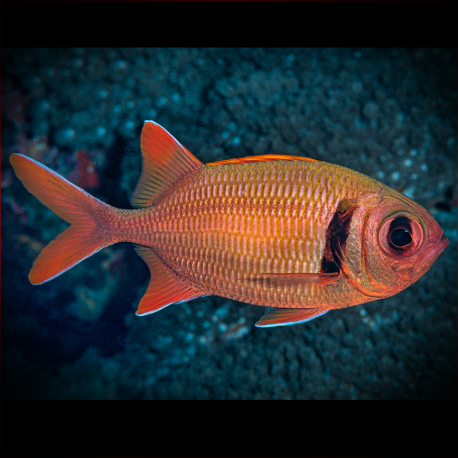More info
Datasheet
| Minimum Tank Size | 600 litres / 158.50 US gallons |
| Maximum Size | 26.0cm / 10.24inches |
| Reef Compatible | Reef safe with caution |
| Temperament | Mostly peaceful but might be aggressive towards similar species |
| Temperature | 22.2°C / 71.96°F - 25.6°C / 78.08°F |
| Specific Gravity | 1.020-1.025 |
| Carbonate Hardness | 8-12 |
| pH | 8.1-8.4 |
General Description
The Shoulderbar soldierfish, scientifically known as Myripristis kuntee, is a member of the Holocentridae family, characterized by its red/grey coloration and secretive nature. These fish are typically most active during low light conditions and may become more visible with time. While they are not generally aggressive towards other aquarium inhabitants, they may prey on very small fish and invertebrates.
Aquarium Suitability
The Shoulderbar soldierfish is considered suitable for aquariums with proper care due to their hardiness. They can be housed with their own species as long as adequate space is provided and all specimens are introduced simultaneously. It is crucial to handle these fish carefully as they have spikes on their head and gills that can easily get caught in fishnets.
Demands, Care, and Hardiness
This species is known for its hardy nature and can thrive in aquariums with sufficient space and suitable hiding spots like overhangs and caves. They are nocturnal creatures, being most active during dim light or darkness. Providing a diet consisting of fish, larger crustaceans, other invertebrates, and small crustaceans like krill or mysis is essential for their well-being.
Reef Suitability
Shoulderbar soldierfish are considered reef-safe with caution. While they generally pose no threat to reef environments, they should be monitored to ensure they do not harm small crustaceans or other delicate reef inhabitants.
Aquarium Setup
To accommodate a Shoulderbar soldierfish, it is recommended to have a tank size of at least 600 liters. The aquarium should have subdued lighting initially to mimic their natural environment, gradually increasing to normal lighting levels. Creating sufficient hiding spots with overhangs and caves is crucial for their comfort.
Behaviour
Shoulderbar soldierfish are mostly peaceful but can exhibit aggression towards similar species if space is limited. They are known to be secretive, often hiding among rocks, and may take time to become more active in the aquarium setting.
Feeding and Diet
These fish have a varied diet that includes fish, larger crustaceans, other invertebrates, and small crustaceans like krill and artemia. It is advisable to feed them when the lights are off initially, and live food may be necessary to entice them to eat.
Dimorphism
Shoulderbar soldierfish exhibit no distinctive dimorphic characteristics, and captive reproduction information is not provided in available data.
Habitat and Distribution
Native to the Indo-Pacific region, particularly found from East Africa to French Polynesia and the Hawaiian Islands, the Shoulderbar soldierfish inhabits a wide range of marine environments excluding the Red Sea, Gulf of Aden, Persian Gulf, and Indian coast. Their distribution extends from Tosa Bay in Japan to the Great Barrier Reef and Lord Howe Island.

